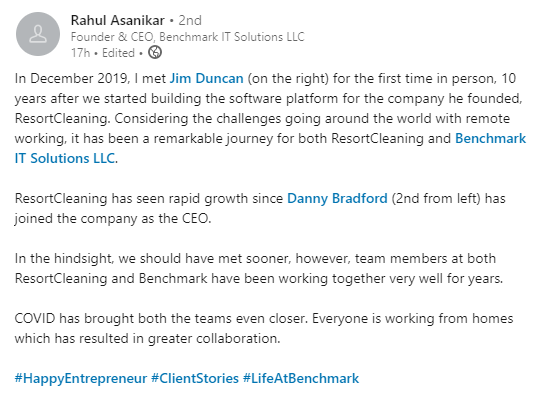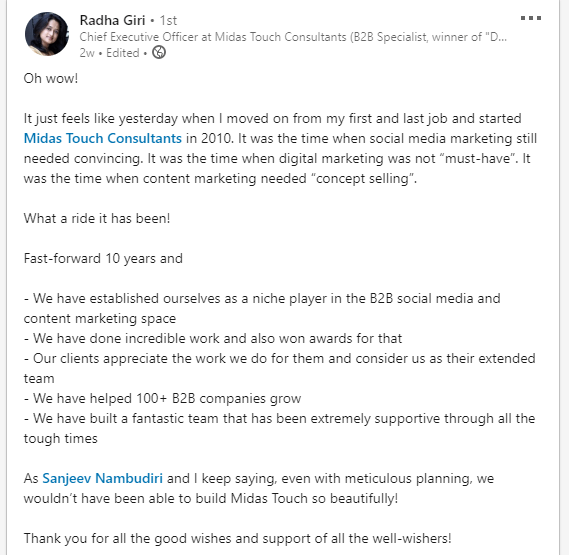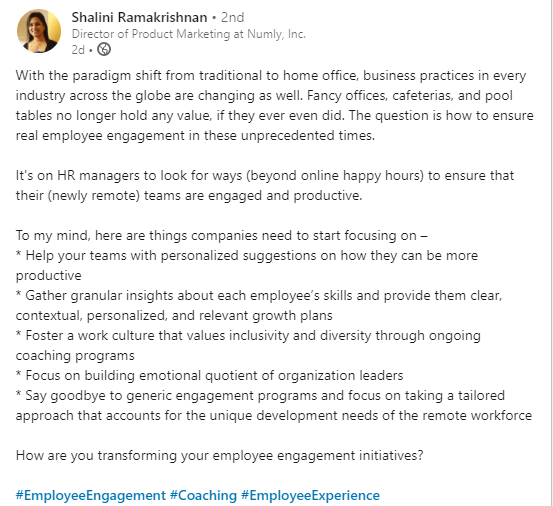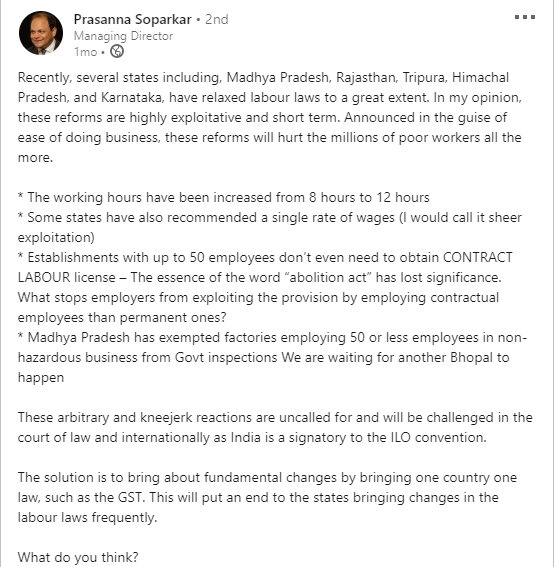Mid-sized technology product and services companies have always been somewhat more focused on sales than marketing. And B2B tech marketing has never been easy.
Business leaders and marketers in technology companies have to juggle between several platforms, ensure a meaningful omnichannel presence and do everything in the book and yet there’s always room for improvement in how they market their products and services.
Conventionally, B2B technology companies were largely dependent on the word-of-mouth recommendations passed on by clients to their peers and others in the network, the powerful network of the founders, and CXOs who are most likely alumni of prestigious universities and B-schools or the good old outbound route.
Gradually, targeted email campaigns, presence at tech events, expos, and sponsoring tech conferences were also brought into practice to reach out to new potential customers. The mid-size tech companies with potential clients located primarily in the USA and other English-speaking geographies were pursuing all of these, in tandem to attract new customers. Of course, all that was supplemented by a hefty focus on travel by the sales pros and key executives.
The pandemic, however, has changed everything.
We’ve put together this handy guide for B2B tech companies who are wondering what to do to get their marketing game on. The question on their minds is, whether or not to focus on marketing during this time. (the answer is, Yes)
This guide is for every B2B technology company that is striving to tap into new customers, is eager to retain the existing ones, and does not want to get washed off by the competition.
This guide can help B2B technology businesses direct their content marketing efforts to survive the pandemic and thrive in the situations that will abide after.
This guide covers
- Changing Dynamics of B2B Tech Sales
- Why now is the time to do marketing
- An “all bases covered” playbook covering content, social media and personal branding of founders
- The ROI – What you will get
Changing Dynamics of B2B Tech Sales
At the onset of the pandemic, B2B technology businesses weren’t directly impacted. But this gradually manifested into a considerable hurdle. IT sales is faced with obstacles all around. Suddenly, every potential customer of the B2B tech companies had a fully remote team, operations were shifted online, processes were overhauled and person to person contact became very different.
Read: Why COVID-19 Has Changed IT Services Sales Forever
With severe restrictions on travel, sales reps could no longer travel for meetings. As things stand, even after travel restrictions are lifted, things won’t return to normalcy soon, and even for the local clients, setting up face-to-face meetings in the times of social distancing is going to be quite impossible. Moreover, all events and conferences for the entire year are canceled or moved online, nullifying the prospect of meeting potential clients, networking, and meeting new people. Tech companies can, obviously, no longer get the visibility they otherwise would.
The traditional sales channels are being constrained even more than usual (which were already getting outdated – who answers cold calls made to the office landline when everyone is practically working from home?) and other outbound methods such as email marketing are facing too much competition (you don’t want to spend your marketing efforts simply adding to the pile of emails your client receives each day), a fresh approach towards marketing is the need of the hour.
Obviously, doing nothing is not an option. Clearly, the pandemic demands B2B tech companies push their boundaries and think outside the box to nail marketing now to outlast the tough times.
Why NOW is the time to do marketing
Unfortunately, the first expense item to take a hit during the pandemic was the marketing budget. ‘If customers aren’t buying, why to spend on marketing?’ was the impulsive call that several business leaders and marketers took in the first half of 2020.
But this approach WILL prove absolutely fatal to B2B tech companies.
The big economic numbers might be slowing down, but that absolutely doesn’t mean that your potential clients do not need a solution for their pressing business problems. In fact, with events canceling, even these clients are exploring other avenues to find solutions that are the right problem-solution fit for their needs.
Now is the right time to become visible in their eye line with valuable content that focuses on solving the business problems that plague your customers. ‘Out of sight is out of my mind’ and you don’t want to be out of the eye-line of your customers at this crucial time.
Of course, you have to be empathetic, and hard-selling like before seems a little out of place but there couldn’t be a better time to grow the top of the funnel and to nurture your audience with value-adding content.
In fact, with no commute and people -including business leaders and decision-makers working from home, there has been a significant rise in the time spent online. People are consuming content online, the only question is, whose content is it?
Sooner or later, your clients are going to be looking around for the right solution and this is when you want to be top-of-the-mind. Now is the time to invest in creating customer-focused content that can prove your authority and expertise and ensure your offering appears to be the most viable option for your target audience.
Once you decide you want to leverage the situation and direct your content marketing efforts other questions will arise. Which channels are to be explored? What type of content should be created? How often should the social media posts go live? Who should your target?
Let’s explore each in detail!
An “all bases covered” playbook
Let’s talk about content
It is needless to say that in the era of screen fixation, remote working, and fewer avenues to strike a face-to-face conversation with your potential clients, digital content is truly the king. Investing in content creation at this stage will not only help you come into the much-needed spotlight but also help you in the long run, especially if you choose to create timeless content pieces that are going to be valuable today and in the future.
Let us have a look at the type of content B2B tech companies should be creating right now!
- Informative Content
Nothing makes your content more worthwhile than true utility to your audience. Irrespective of where your customer is in the buyer’s journey, you should have relevant, valuable, and highly informative content to offer. This content should not only be engaging to read with extremely accurate information but should also have key takeaways that can help your readers solve their real-world problems. The content need not necessarily lead to a conversion, at least not through the first piece your readers consume. But it should be worth remembering, useful, practical, and authentic enough to build trust with your users while also resonating with their problems and challenges.
Focus on creating content pieces that have actionable insights, especially in times like these where your customers are anxious and are quite frankly looking for solutions, not stories.
For example, Thinksys, a software development services company has extended quick guides for thriving the pandemic with its articles such as The Top 5 Factors To Consider While Developing Products With Remote Teams and Cost-Saving While Maintaining The Pace Of Product Development– the topics the audience is exactly looking for- from remote teams to cost-saving.
Another excellent example is the blogs from construction technology services company Virtualize Services. They have very cleverly created content that amalgamates their service areas with the newly required mandates and changes the construction sector is going through in the USA.
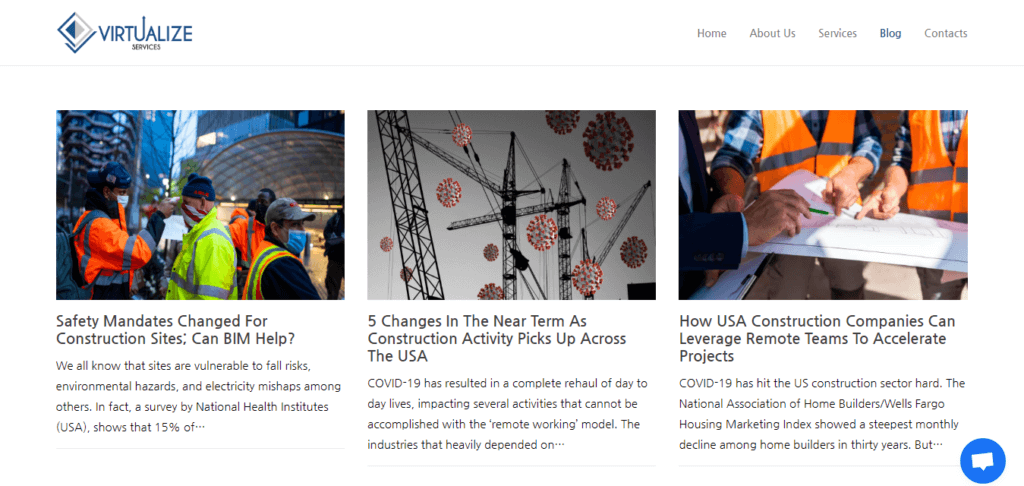
- Content riding on current topics
Staying relevant is crucial for making any marketing activity, a success, especially in times like this. Ghosting the current topics is obviously not an ideal route. Your audience needs to know, in their unique context, how your company, its products, and services are relevant to them in the current times. Hence it is extremely important to create content that rides on current topics. This content might not be usable once the trend subsides but, it is worth the effort for the contextual impact.
You can integrate your offerings with the current topics. For instance, data science platform Rubiscape has created articles like The World Post COVID-19 – AI to The Rescue in The Battle Against Pandemic or how Analytics services company Inteliment has spoken extensively about the Role of data and analytics in COVID-19 response.
Aroscop, an ad-tech company has put together several articles around the changing dynamics of consumer behavior and digital ad rate trends due to COVID-19 which are also a fine example of writing about current topics while continuing to focus on the key concerns of your target audience.
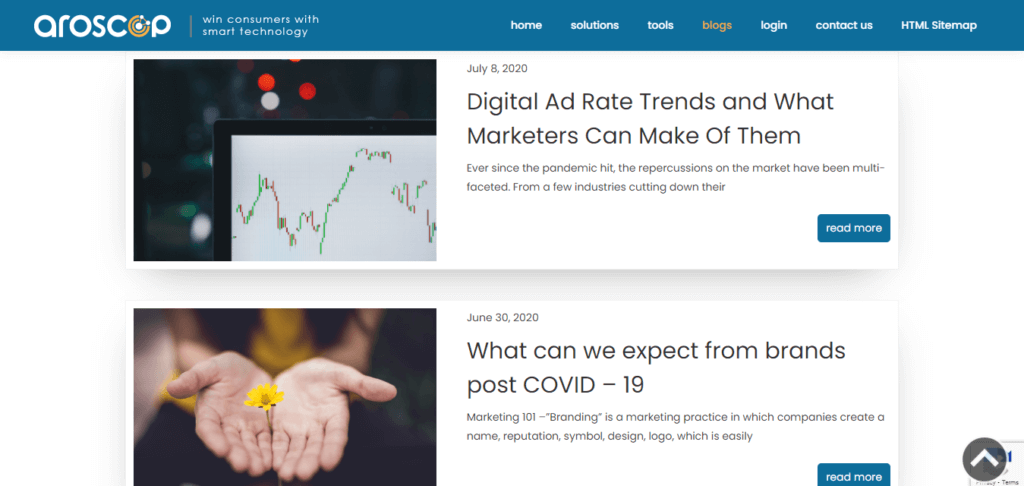
- Content demonstrating business as usual
With uncertain times, it is quite natural that your potential customers (or the existing ones) are anxious. And while being empathetic is important, the real challenge is that no one really knows what to do next. Hence, creating handy guides that can help in getting back to business or preparing their businesses once the ‘new normal’ sets in can be impactful.
Fintech company Simple2Trade has been creating blogs such as How Technology Can Help Drive Trading Strategies As “Business As Usual” Kicks off Again or COVID and Customer Onboarding – What Financial Services Companies Need to Do which can prove to be very useful for their customers and potential clients.
- Content talking about Remote working
Not enough can be emphasized about how remote working has impacted several businesses. For most businesses, this entire remote working wave was unexpected, and the transition hasn’t really been a cakewalk. Especially since remote working looks like it is here to stay, businesses are clueless and do not know how to go about remote hiring, onboarding, and employee engagement while everyone works remotely.
In the context of technology services companies, outsourced product development company Forgeahead has chosen to focus on what WFH means for the enterprise software target segment. They have created content highlighting the security challenges enterprises need to address in the remote working age as well as speaking of UI changes.
Similarly, creating an enterprise mobility strategy for remote working by BenchmarkIT can strike the right chord with the enterprise product audience hit by a WFH disruption. Such content practically ticks all boxes- informative, relevant, and helpful.
- Content demonstrating hiring and culture
The job market has been merciless and as per the experts, with the approaching recession, it is only going to get worse. But companies are still going to hire high-quality people. This is why writing about your company culture around hiring is important. It not only helps you put the best foot forward as a brand but also helps in attracting rich talent to your organization, in times of uncertainty.
With a multitude of opportunities for top talent, content like ‘We work on highly complex technology projects – here is how it changes whom we hire’ by Wissen can be refreshing as well as inspirational. If your organization is doing anything out of the box to engage, retain, and nurture your employees or customers, this is the time to talk about it!
- Visual and other types of content
It is important to consider the possibility of having an audience that doesn’t consume a lot of textual content. It is about time to get creative and present diverse content types so that you don’t miss out on anyone on the radar! Especially if your past marketing experience for a particular niche in B2B tech has been driven by diversified content types, you should actively focus on creating more.
For example, TruckX Inc has been creating highly engaging visual content that focuses on the trucking companies that are their customers and truckers who are their end-users for promoting their products.
This could also be a good time to release podcasts or host webinars since a lot of people are working towards upskilling. Presenting your customers or your internal thought leaders could be a very important move for your branding efforts.
Let’s talk about social media
Unlike B2C companies, B2B companies seldom fully acknowledge the power of social media. The perception that social media presence works more for B2C companies has sometimes made B2B tech companies stay away from social media marketing. Most companies, especially the small or midsize ones, have almost no presence on social media and look at it as an unnecessary effort. They simply post links to their new content pieces or to announce new collaborations or major updates. They have no expectations from the efforts and those expectations are met!
If you are not actively engaging on social media platforms, you should start now. And here’s what you should post on social media, apart from sharing links to your content such as blogs, whitepapers, and ebooks.
- Hiring related updates
Speak, scream, and tell the world if you are hiring during the pandemic. Not just job seekers, but your customers will also have a newfound respect for you once they learn you are hiring in these tough times. Because it simply means- your business is up, running, and doing well, you have future plans put together, you have enough projects lined up which basically means you know what you are doing and this is exactly the type of company anyone would want to do business with!
- Relevant content – tips and tricks
You can’t expect each of your potential clients to read through the detailed content that you create and hence your company page should be alternating between sharing links to content and sharing tips and tricks as a post on social media. These not only provide quick assistance to the ones who are looking for it but also serve as a great engagement engine. Especially if the tips and tricks you share are new, experience-based, or unique, you can expect users to engage on the post, which essentially helps in increasing the reach of your post and ultimately your brand.
Let’s talk about Personal Branding of founders
Founders are invariably the face of the company and play a huge role in establishing the brand of the company. Especially for the small, midsize companies and B2B tech startups that do not have the cash flow to invest in full-blown advertising, the company branding is subtly established via the founders. When it comes to cracking large value deals, clients look for companies that have trustworthy founders who they’ve read about or seen and interacted with on social media.
If you are a founder of a B2B company that is looking to establish itself during these changing times, there couldn’t be a better time to build your personal brand. B2B tech founders have a great deal of industry experience, good references, and knowledge of the ecosystem. Creating content to focus on personal branding aligned to the company’s brand can be the key to engage customers, leave a long-lasting mark in the mind of the audience as well as attract new talent to fill in key positions in the company. Being social-media shy is not ideal. Today, there is no excuse to have dormant LinkedIn profiles or be invisible on other platforms such as twitter. People need to know the face behind an organization, especially when it comes to small and mid-size companies.
Here’s how you can get started with founders’ personal branding:
- Share stories
It could be personal growth experiences of the founder or their take on anything they hold an expertise in. Founders of tech companies are tech leaders in their respective fields and over the years have garnered tons of experience. This could be not only an interesting read but also create thought leadership. Founders can share their interesting perspectives, opinions, and their personal journeys to create a bond with your readers along with amplifying the company branding.
Here are a few examples of how founders can share stories, opinions, and experiences:

- Success stories
Resonating with your audience and exhibiting your expertise is commendable, but what makes your potential customers take the leap of faith are your success stories. You can share your success stories, client testimonials or peculiar experiences of solving challenging business challenges and those will usher in a direct impact. Since these are the stories your potential clients are going to read and relate to and they are a data-backed proof of your expertise and efficiency as an organization.
For sure, be careful that your story doesn’t brag, overpromise, and is not salesy. Think of it as a candid exchange between your network and remember a little goes a long way.
Here are a few great samples:
Current content
Founders who want to take up personal branding seriously need to remember that this activity is not short-term and needs a lot of nurturing, just like real-world relationships. And hence, if you are only going to be talking about your journey, your products, and your experiences, you are going to be uninteresting for your reader. It is important that you write about current topics, share your opinions on how it will impact the space your customers care about. It’s also ok to be controversial if you can justify your stand.
You can check out how these founders have spoken about current issues which have helped them stay relevant within their network:
The ROI – What you will get
As we reiterate whenever the discussion of B2B marketing picks up, we firmly believe that strategic B2B marketing should be done with the intention of gaining brand visibility to the right set of audience in exactly the right context.
Putting in efforts and investment in building a comprehensive marketing strategy based on all the points mentioned in this guide can yield that brand visibility.
You can create a positive impression of your brand in the minds of your target audience.
You will be more visible. You will be understood better.
Your target audience will be able to place you in the right frame in light of exactly what you can do for them.
Then, you will see them reaching out to you when they feel motivated enough to want to solve those specific business problems.
You will be the frontrunner in that race, maybe even the only runner. There will be a number of signs along the way that this is working.
You will see a noticeable difference in connection/follow requests for your founders’ social media pages, improved web traffic, and a warmer response to your sales outreach since your customers already know about you!
Maintaining the consistency and context with your content is the bottom line. Traffic, engagements, and leads will follow suit. That’s the way to beat the COVID-induced slowdown.
Let’s connect if you would like to know how this would work for you too.
Disclaimer: The examples shown here are all live and in the public domain. Not all the companies mentioned here are current clients of Midas Touch







